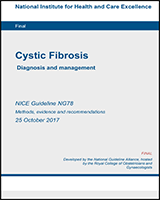From: 9, Pulmonary monitoring, assessment and management

NCBI Bookshelf. A service of the National Library of Medicine, National Institutes of Health.
| Comparison 4. Positive expiratory pressure (PEP) compared to no airway clearance technique for CF | ||||||
|---|---|---|---|---|---|---|
| Outcomes | Illustrative comparative risks* (95% CI) | Relative effect (95% CI) | No of Participants (studies) | Quality of the evidence (GRADE) | Comments | |
| Assumed risk | Corresponding risk | |||||
| No airway clearance technique | Positive expiratory pressure (PEP) | |||||
| Sputum dry weight (grams) Follow-up: mean 2 days | The mean sputum dry weight in the control groups was 0.97 | The mean sputum dry weight in the PEP groups was 0.03 lower (0.48 lower to 0.42 higher) | 17 (Placidi 2006) | ⊕⊕⊝⊝ low1 | ||
| Sputum wet weight (grams) Follow-up: mean 2 days | The mean sputum wet weight in the control groups was 13.98 | The mean sputum wet weight in the PEP groups was 1.8 higher (1.72 lower to 5.32 higher) | 17 (Placidi 2006) | ⊕⊕⊕⊝ moderate2 | ||
| Lung function - FEV1 % predicted Scale from: 0 to 100 Follow-up: mean 2 days | The mean FEV1% predicted in the control groups was 60.3 | The mean FEV1% predicted in the PEP groups was 2.1 higher (11.73 lower to 15.93 higher) | 16 (Braggion 1995) | ⊕⊝⊝⊝ very low3,4 | ||
| Lung function - FEV1 (litres) Follow-up: mean 2 days | The mean FEV1 (litres) in the control groups was 0.99 | The mean FEV1 (litres) in the PEP groups was 0.01 higher (0.18 lower to 0.2 higher) | 17 (Placidi 2006) | ⊕⊕⊝⊝ low1 | ||
| Lung Function FVC % predicted Scale from: 0 to 100 Follow-up: mean 2 days | The mean FVC % predicted in the control groups was 81.6 % predicted | The mean FVC % predicted in the PEP groups was 1.2 higher (12.88 lower to 15.28 higher) | 16 (Braggion 1995) | ⊕⊝⊝⊝ very low1,3 | ||
| Lung function - FVC (litres Follow-up: mean 2 days | The mean FVC (litres) in the control groups was 1.96 | The FVC in the PEP groups was 0.05 higher (0.35 lower to 0.45 higher) | 17 (Placidi 2006) | ⊕⊕⊝⊝ low1 | ||
| Oxygen saturation - Spo2 % Scale from: 0 to 100 Follow-up: mean 2 days | The mean oxygen saturation (spo2) in the control groups was 94.6 | The mean oxygen saturation (spo2) in the PEP groups was 0.3 higher (0.58 lower to 1.18 higher) | 17 (Placidi 2006) | ⊕⊕⊕⊝ moderate2 | ||
The basis for the assumed risk (e.g. the median control group risk across studies) is provided in footnotes. The corresponding risk (and its 95% confidence interval) is based on the assumed risk in the comparison group and the relative effect of the intervention (and its 95% CI).
Abbreviations: CI: confidence interval; FEV1: forced expiratory volume in 1 second; FVC: forced vital capacity; MD: mean difference; SpO2: peripheral capillary oxygen saturation
The quality of the evidence was downgraded by 2 due to very serious imprecision as 95% CI crossed 2 default MIDs
The quality of the evidence was downgraded by 1 due to serious imprecision as 95% CI crossed a default MID
The quality of the evidence was downgraded by 2 due to lack of blinding, attrition bias and reporting bias
The quality of the evidence was downgraded by 2 due to very serious imprecision as 95% CI crossed 2 clinical MIDs
From: 9, Pulmonary monitoring, assessment and management

NCBI Bookshelf. A service of the National Library of Medicine, National Institutes of Health.